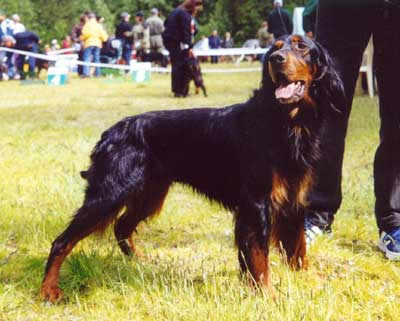
The Gordon Setter has been favored by bird hunters for its great stamina and ability to hunt on land, in water, and in bad weather!
The Gordon Setter, though a lesser-known sporting breed, is a skillful bird dog. It originated in Scotland in the 1600′ s and was called the Black and Tan Setter. In the late 1700’s the breed was refined and made popular by Duke Alexander of Gordon and hence was renamed the Gordon Setter.
Gordon Setters make devoted and obedient pets. Not only are they skillful bird dogs, but they also make wonderful companions. Their gentle nature makes them a good choice for families. They tend to get along with everyone, and do very well with children. They get along with other dogs, and can be fine with cats and other household pets if socialized properly. This breed loves physical activity, so it is wonderful for the active dog lover.
When selecting a Gordon Setter, check bloodlines for hip dysplasia and eye problems. This breed is also somewhat prone to thyroid problems, so it might be a good idea to request a checkup.
- Kingdom: Animalia
- Phylum: Chordata
- Class: Mammalia
- Order: Carnivora
- Family: Canidae
- Genus: Canis
- Species: lupus familiaris
Common Name(s)
Gordon Setter, Black and Tan Setter
Breed Type
The Gordon Setter is a lesser-known sporting breed. A skillful bird dog, the Gordon Setter also makes a wonderful companion.
Background
The Gordon Setter originated in Scotland in the 1600s. Originally called the Black and Tan Setter, the breed was refined and made popular by Duke Alexander of Gordon in the late 1700s, and hence renamed the Gordon Setter. It was favored by bird hunters for its great stamina and ability to hunt on land, in water, and in inclement weather.
Description
The Gordon Setter has some similarities in appearance to English and Irish Setters, but it can be defined by its unique build. It is a bit larger, with a bigger head, and also has a distinctive black and tan coat that is silken and wavy. Its head is rounded with a rather long muzzle and broad nose. The eyes are dark, and the ears large and set low. The traditional black and tan markings are the only ones acceptable for show, although a small amount of white on the chest is allowed. Mostly tan dogs, as well as buff and red ones, are sometimes found, but these colorings are considered defects.
Male Gordon Setters are 24 to 27 inches tall and weigh 55 to 80 pounds. Females are 23 to 26 inches tall and weigh 45 to 70 pounds.
Care and Feeding
Gordon Setters do well on diets that include poultry, potatoes, wheat and corn. They are prone to bloat, so it is advisable to feed them two or three small meals per day.
A Gordon Setter’s coat requires little more than regular combing and brushing to keep it looking its best. Extra brushing may be required when shedding, and tangles and mats should be removed promptly. Baths should be given only when necessary, and the nails should be clipped as needed. Removal of the dewclaws is optional with this breed, although it is probably a good idea for hunting dogs. This should be done at a few days of age.
Gordon Setters need annual checkups for good health. Vaccinations are due as follows:
- 6-8 weeks: Distemper, Leptospirosis, Hepatitis, Parainfluenza, Parvo, and Corona virus (DHLPPC)
- 10-12 weeks: Second DHLPPC
- 14-16 weeks: Third DHLPPC and rabies
- Annually: DHLPPC and rabies booster
Gordon Setters shed moderately. Regular vacuuming is important if they are to be kept indoors.
Housing Your Dog
Gordon Setters are not good dogs for those living in small spaces. They need room to move and a place to roam outdoors. A good fence is a must for the dog’s safety.
Social Behaviors
The Gordon Setter is a pleasant and gentle breed, and it tends to be amicable with everyone. It does very well with children. Gordon Setters are sometimes reserved around strangers, but usually warm up to them quickly. They get along well with other dogs, and can do well with cats and other pets if socialized with them as puppies.
Handling and Training
Training the Gordon Setter is fairly easy, but requires a certain amount of patience and consistency. Starting early is important.
Activities
Gordon Setters need plenty of exercise, including a long walk and time to run off-leash each day. Puppies should not be overworked, because this can damage their developing joints.
Breeding/Reproduction
When selecting a mate for your Gordon Setter, check bloodlines for eye problems and hip dysplasia.
Common Health Problems
The Gordon Setter is prone to cataracts, which may require surgery if they are bothersome. Hyperthyroidism is also a concern, but may be treated with medication. It is important to know the signs of bloat if you own this breed, because if not treated quickly, it can lead to death.
Availability
The Gordon Setter is not an especially common breed, so it may be hard to find in many areas. Prices are usually between $600 and $800.
References
- Animal-World References: Dog Breeds
- “Gordon Setter”, Dog Breed Info Center, Copyright 1998-2008
- “Gordon Setter”, Wikipedia, Copyright 2008
- Cusick, William D., “What to Feed a Gordon Setter”, Referenced online, 2008
- “Gordon Setter,” World Almanac Education Group, Copyright 2006
http://www.history.com/encyclopedia.do?vendorId=FWNE.fw..go067300.a - “Gordon Setter Puppies for Sale”, Copyright PuppyFind.com, LLC, Referenced online, 2008
Featured Image Credit: Anna Tronova, Shutterstock
